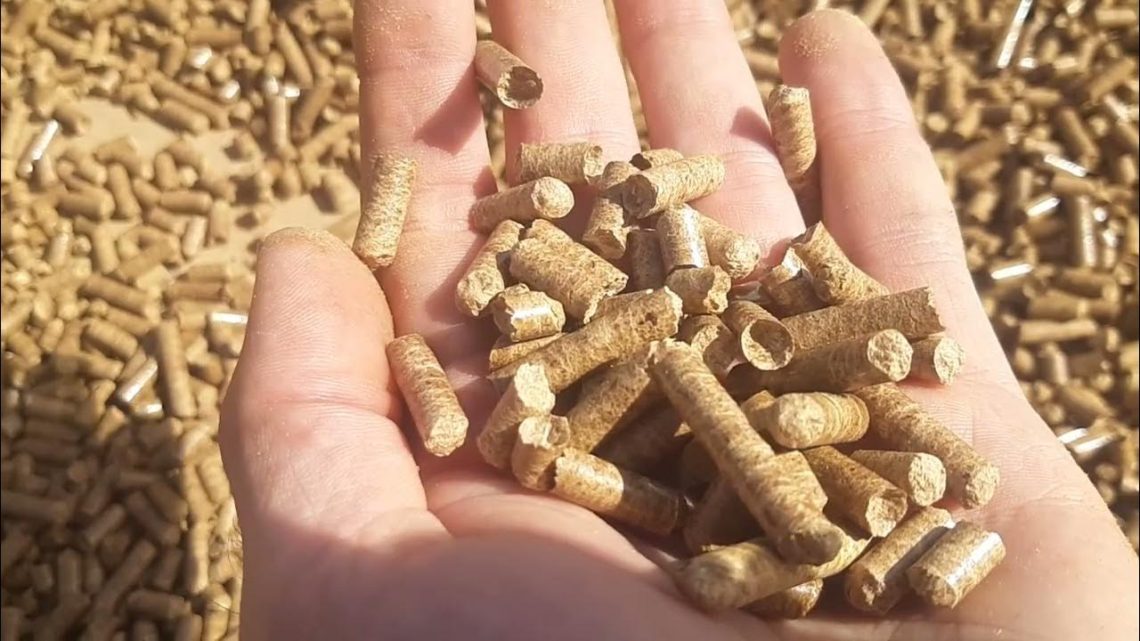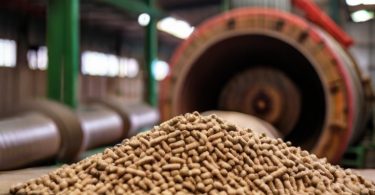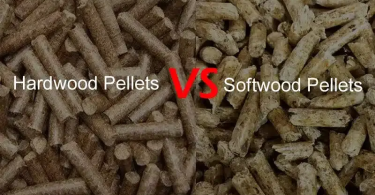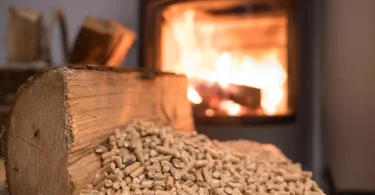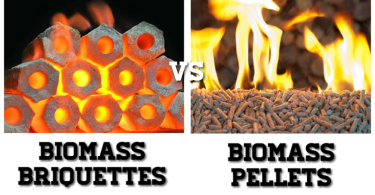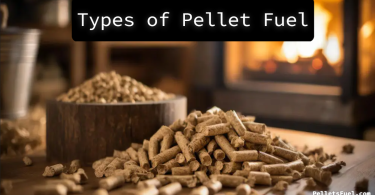- What Are Wood Pellets?
- How Are Wood Pellets Made?
- Wood Pellets for Heating
- Wood Pellets for Power Generation
- Wood Pellets for Industrial Boilers
- Types of Wood Pellets
- Premium or Standard
- Softwood
- Hardwood
- Agro-Pellets
- Heating-Grade
- Food-Grade
- Advantages of Wood Pellets
- 1- Multiple Uses
- Wood Pellets for Stoves
- Wood Pellets for Pellet Smokers
- Wood Pellets for Power Generation
- Wood Pellets for Animal Bedding
- Wood Pellets for Cat Litter
- 2- Slow Burning
- 3- Heating Value
- 4- Smoke
- 5- Better Fire Control
- Are Wood Pellets Better than Wood?
- Why Should I Switch to Wood Pellets?
- How to Store Wood Pellets?
- Final Thoughts
Always in search of a more sustainable way to store and release energy for residential and industrial heating purposes, wood pellets or fuel pellets have been gaining attention in the past decades. Although the technology is not new, the long-term possibility for storage, ease of combustion, temperature control, and other advantages have made fuel pellets gain in popularity. But what exactly are wood fuel pellets?
What Are Wood Pellets?
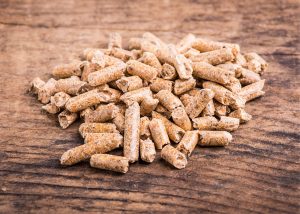
Wood pellets are tiny pellets made of woody materials. They can be made from wood or agricultural waste and can be a sustainable solution, for as long as raw materials used as feedstock in the production process are sustainably sourced. These materials can come as a waste from the wood processing sector or from the agricultural sector. In addition to these, large-scale production facilities also use freshly cut, timber to make pellets.
Pellets are very easy to store and to transport. Thanks to their high energy density and ease of maneuvering in both residential and industrial sectors, they are a favored solution for heat production in several countries. Although it is not the preferred way of heating almost anywhere in the world, this type of fuel has a lot of potential, including helping mitigate the effects of climate change.
As fuel pellets feature high energy density of more than 4.5 MWh/ton, fuel pellets can simply do more with less storage space and lower transportation cost. In industrial use, pellets are easy and cheap to transport in bulk. In residential use, they come prepackaged in bags of 15-18kg, which is light enough to provide ease of handling, while providing a full day of heating for an average home.
How Are Wood Pellets Made?
The ease of maneuvering and packing comes from their uniform shape and size. Wood pellets come in varying sizes, with a diameter of anywhere between 5 and 10 millimeters. While smaller wood pellets are mostly used in residential heating solutions, those with larger diameters are used in industrial application and for power production.
The pellets are made and packed according to a preset size. During the production process, several steps are necessary to ensure that the final product is of a certain quality. Wood pellets or fuel pellets, therefore, undergo several steps before they are ready to be shipped.
- Gathering the feedstock – the feedstock used in pellet production can come from various sources. The raw materials are mostly wooden in origin, so the final product can be very green and even sustainably sourced. Timber, wood, and agricultural waste can all be used to produce pellets. The highest possible quality of the pellets is obtained by using high quality timber materials with no bark on them.
- Milling the feedstock – once in the production plant, the feedstock has to be milled and standardized in size. Different choppers and mills, such as hammer mills, are used to produce a material similar in consistency to sawdust. This sawdust is then dried until it reaches the desired moisture content. In most cases, the organic fibrous material that is used as feedstock needs a moisture content of anywhere between 16-24%. This ensures a smooth extrusion process and results in wood pellets of the highest possible quality.
- pelletizing or extrusion – once the organic materials have been dried to the desired moisture level, they are sent to the extrusion or pelletizing machine. This machine uses rollers and a lot of pressure to squeeze out the sawdust-like material through small holes or dies. During this process, lignin gets released from the wood. This natural glue helps bind the pellets and give them their final form. Due to the friction, high temperatures developed during the production process, so a lot of attention and the subsequent cooling phase are necessary.
- Cooling – during the cooling phase, which is carried out in specialized coolers, the temperature of the wood pellets is brought down abruptly, which helps solidify the lignin and ensures that the pellets keep their uniform shape and size. As the pellets are broken off from the extruder, their length can vary, but in handling and combustion of fuel pellets, it is their diameter that is of vital importance.
- Storage – once they have been cooled, wood pellets can be stored. The storing itself is an optional stage in their production which does not have to be carried out. They can be stored in bulk or prepackaged in 15-18kg bags. If they are packed in bags, the bags are usually placed on pellets carrying 1-1.2 tons each.
- Packing – the packing stage itself is carried out in machines which use hoppers to weigh the pellets precisely. The bags that the pellets are packed in are made from plastic and they are sealed off in such a way that moisture cannot get in. The final pellet product should have a moisture content of between 5 and 10%, which ensures the highest possible combustibility of the material without making it too fragile to pressure.
Moisture contents that are higher than this, especially if they go above 24%, can seriously damage the wood pellets. For this reason, in-home storage needs to be done in a dark and a dry room where water and moisture cannot penetrate. As they are made of organic materials, natural decomposition can occur once moisture levels increase. For as long as the bags are kept undamaged, wood pellets can last for decades.
Different Uses of Wood Pellets
As each kilogram of wood pellets carries a little bit more than 4.5kWh of energy, they present very dense energy storage. This gives wood pellets a variety of uses, which mostly includes heating, power generation and industrial applications. Cooking also makes it to our list, although we will not dwell on it, as this is a marginal use.
Wood Pellets for Heating
Wood pellets are used for heating in both residential and commercial applications. In residential applications, pellets are used as a fuel for stoves and furnaces which then heat the space and provide energy needed for cooking. These stoves burn very efficiently and using wood pellets as a fuel source also leaves one with very little ash. As a combustion process is very efficient, there is very little smoke and a very small amount of PM particles gets released into the environment.
Around 1 million households in the United States use wood pellets as the source of heat during winter. The situation is similar in Europe, although the European Union is looking for ways to increase the usage of wood pellets in large scale operations. In the EU, entire blocks of buildings can be heated using this fuel source and central heating as a heat delivery method.
| Country | Amount of Pellets Used per Year |
| UK | 4,540,000 tons |
| Italy | 3,300,000 tons |
| Denmark | 2,500,000 tons |
| Netherlands | 2,000,000 tons |
| Sweden | 1,650,000 tons |
| Germany | 1,600,000 tons |
| Belgium | 1,320,000 tons |
Source: Wikipedia
Wood Pellets for Power Generation
In the power generation sector, pellets are mostly used in urban areas in cogeneration settings. At first, as pellets are burned, the heat that they produce is used to evaporate water, which in turn pushes turbines and produces electricity. The residual heat is used to heat residential homes and public buildings.
Thanks to the dense energy that they store, wood pellets are also used in large-scale operations for energy production. It is not impossible to convert old coal-powered power plants to run on this new type of fuel. These projects are very lucrative, and can give new life to the existing plants and help transition economies to green or renewable energy sources.
Wood Pellets for Industrial Boilers
Wood pellets also find their way into industries where a lot of heat needs to be released in a controlled way. These industries rely on industrial boilers, where fuel pellets are burned to produce heat and steam, which can generate electricity, or make machines run. This heat also has application in production facilities where materials need to be melted or where a mixture or high temperature and pressure is necessary to accommodate chemical reactions.
Types of Wood Pellets
As the feedstock for making wood pellets is so varied, so are the types of wood pellets that we get at the end of the production line. With this in mind, we should consider premium or standard pellets, softwood pellets, hardwood balance, agro pellets and those that are safely used for heating and cooking. Let’s consider each of these types of pellets in more detail.
Premium or Standard
When it comes to premium or standard pellets, it is a usual misconception that premium pellets have to be made out of virgin, raw wood. In fact this is not the case. Premium pellets are made from high calorie wood and contain very little dust. They are of a pretty uniform size, and release a lot of heat when burned. Of course, they come at a premium price as well.
When it comes to standard pellets, their size may vary to an extent. This does not mean that their diameter should vary, but rather their length. They may also contain some dust and they may not be as durable under pressure as premium pellets. However, this does not mean that they should crumble easily, as they should be durable enough to undergo the transportation process from the storage chamber to the combustion chamber in your home.
Softwood
Softwood pellets are generally made out of pine, mahogany, cedar and spruce wood. They burn faster than hardwood pellets, but may be better if you need a faster release of heat into your home. They generally cost less than hardwood pellets.
Hardwood
Hardwood pellets usually have a premium price. They are made out of birch, poplar, and elm wood. They have very high energy density and very low water content. This makes them perfect for larger homes and for those who do not want to deal with a lot of ash every day. This type of pellet generally burns longer than softwood pellets and those that use it generally say that this fuel pays off in the long run.
Agro-Pellets
Agro-pellets or agri-pellets are made from agricultural waste. This waste includes barley and wheat straw as well as corn stocks and any other agricultural waste that large quantities of are available. In general, agricultural pellets provide a good heating solution but stores less energy and produces more ash than wood-based pellets. As it is made from a waste from another industry this pellet generally comes at a lower price tag, but demands special stoves that can handle this type of pellet.
Heating-Grade
When it comes to pellets used for heating, any kind of pellet is good enough. With some types of pellets, special palate stoves are necessary, as more ash and sooth can be released by certain types of pellets than by some other types. In general, if you are looking for the best possible solution for home heating, calorie-dense, wood-based pellets are the best solution as they pack the most heat in each bag.
| Fuel | Energy Density (kWh/kg) |
| Wood Fuel Pellet | 4.8 |
| Wood Chips | 3.5 |
| Wood | 5.3 |
| House Coal | 7.5-8.6 |
| Heating Oil | 11.8 |
Source: ForeStreetSearch.gov.uk
Food-Grade
Food grade pellets are generally used stoves, grills and smokers in residential use. These pellets can only be made out of certain types of wood that does not release oils or resin or smells during their combustion process. The last thing you need is a steak that smells of pine. Food grade pellets are made of virgin raw wood and especially wood that hasn’t been treated in any way. Food-grade pellets should not be made out of waste materials, as there is a chance of contamination with different chemicals and pollutants. For this reason, you should stay away from any pellets where non-virgin materials have been used.
Advantages of Wood Pellets
As we have mentioned several times, there are many advantages to using wood pellets instead of wood or any other fuel for that matter. When it comes to fuel pellets they have multiple uses, are slow burning, provide a good heating value, produce less smoke during combustion and offer you better fire control than many other fuels. Let’s go and break these down.
1- Multiple Uses
Fuel pellets have multiple uses. So far, we have seen that they can be used in both residential and industrial sectors. Further breaking down their use brings us to using wood pellets for stoves, grills, smokers, animal bedding, cat litter and even power generation. Let’s consider these in more detail.
-
Wood Pellets for Stoves
The most common type of residential use of wood pellets is in special stoves, for home heating and cooking. Beware that wood pellets cannot be used in just any type of stove. The stove commonly used for wood pellets is specifically designed for a certain size and a certain type of wood pellets. These stoves contain a small storage area which can usually accept less than 30 kg of pellets at a time. From here, the pellets are taken to the combustion chamber in a controlled way.
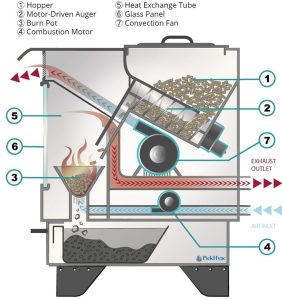
The combustion chamber itself can contain different sensors which monitor the combustion speed and rate of the energy release. Special mechanisms feed new pellets during the combustion process. On top of this, these special stoves have several inlets for fresh air which assists the combustion process and heat distribution throughout the space.
- Wood Pellets for Pellet Grills
There are also wood pellets for pellet grills. These pellets are made from wood that releases no oils, smells or even resin when set on fire. When looking for pellets for a grill, you should be looking for 100% natural products. Natural hickory hardwood pellet, cherry tree pellet and hard maple pellet are some of the best choices for cooking.
-
Wood Pellets for Pellet Smokers
Similarly to wood pellets used in grills, the pellet used in smokers has to be a 100% natural product. Hickory and hickory blends, applewood, cherrywood and hard maple are some common choices for smokers. Please avoid using any pellets that contain biomass, agricultural waste or even parts of evergreen trees.
-
Wood Pellets for Power Generation
When it comes to power generation, fuel pellets are very efficient to produce a lot of power in a short period of time. For this reason, they have been used in power production in coal powered power plants. One added benefit of this approach is that fewer pollutants get emitted during combustion of fuel pellets.
In fact the combustion process releases a lot of CO2, small quantities of PM particles and very little carbon monoxide. For comparison, fossil fuels release a lot of pollutants including sulfur oxides which have been connected to acid rain and the number of respiratory diseases. No similar pollutants are released during the combustion of fuel pellets.
-
Wood Pellets for Animal Bedding
Some cheaper brands of wood pellets are usually used for animal bedding. In this case wood pellets have good absorption power and produce very little dust. They are a natural material that contains no glues, paints or additives and are perfect for animal bedding.
-
Wood Pellets for Cat Litter
Wood pellets are commonly used for cat litter. They are just like any other wood pellets. What some people like to do is to purchase those that have a particularly good smell such as cherry wood or applewood or even wood coming from evergreen trees. This way you get a 100% natural way to handle the waste of your furry little friend.
2- Slow Burning
Although wood pellets are small in size and should burn quickly, you should keep in mind that they’re still very energy dense and that they burn for a long time. Most pellet stoves also have controlled air inlets that allow them to burn the pellet at exactly the right pace to keep your home at the comfortable temperature throughout the day. This slow burning gives you more comfort and more control over your time, as you only need to replenish pellets once to twice a day
3- Heating Value
Wood fuel pellets have a very high energy density. In fact one kilo of wood pellet has up to 4.75 kWh of energy. This is the same amount of heat or thermal energy that gets released by an electric heater in more than two and a half hours of work.
In fact, one ton of wood pellets has the same amount of energy as 120 gallons of heating oil, or 170 gallons of propane, or 16,000 cubic feet of natural gas. To keep them at their peak performance, the pellets should be kept in a dry place. They can release most of their energy stored when the moisture content is between 5-10%. Higher moisture content still means that some energy can be released, but do not forget that the lot of that energy will be tied up into the water vapor that goes out of your chimney, leaving less heat for your home.
| 1 ton Pellet Equivalent | |
| Heating Oil | 120 gallons |
| Propane | 170 gallons |
| Natural Gas | 16,000 cubic feet |
| Heat Energy | 4,750 kWh |
4- Smoke
As they burn in a controlled way, pellets produce much less smoke than burning wood. By controlling the air inlets and the quantity of pellets that gets deposited into the combustion chamber at any moment, pellet stoves ensure that the combustion is carried out in the most efficient way and that little to no smoke is created. The air rising through your chimney is rich in carbon dioxide and may prove to be slightly corrosive, introducing the need for special chimneys.
5- Better Fire Control
Using wood pellets and wood pellet burning stoves leads to a more comfortable experience and better fire control. When it comes to burning fuel pellets, the entire process is automated to the point that you only need to replenish the pellets in the storage area 1 to 2 times a day.
The automated fire control means that the temperature around your home will be even throughout the day. Some more advanced models of pellet stoves also have Wi-Fi features and can be programmed to work only during specific times of day. For example, while you’re at work and kids in school, you can disable the heating altogether.
Are Wood Pellets Better than Wood?
Although they’re made of wood, wood pellets or wood fuel pellets are often criticized because of the additional energy input that is necessary during their production stage. However as they help deal with a lot of wood waste coming from the wood processing industry, they can also be a very green solution, where energy is extracted from a material that would otherwise be considered a waste.
In addition to this, we can make a comparison between wood stoves and wood pellet stoves. The former produces a lot of ash and have an efficiency level of around 40%. The latter has an efficiency level which can go as high as 90%, at least in industrial applications. That means that a lot more energy can actually be used to heat a home then with old wood stoves.
The current energy crisis and the issues between Russia and Ukraine have significantly increased the prices of wood pellets and have slowed down the progression towards this sustainable power source. However, with proper government incentives, this road can easily be resumed.
Considering the fact that the raw materials used for feedstocking wood pellet production can be sustainably sourced, can use waste from other Industries, produce very little ash that can be used as potash in farming and other agricultural applications. and considering the higher combustion efficiency of the entire process, wood pellets can be seen as a better solution for residential heating than traditional wood.
Why Should I Switch to Wood Pellets?
Using fuel pellets provides several advantages to using wood for heating your home. Wood pellets are a very uniform solution for heating with a variety of applications in both residential and industrial sectors. The ease of storage, maintenance and handling also provides a lot of comfort for homeowners. The ease of storage and the low volume also means that you can store the fuel for several winters at a time. In all respects, fuel pellets are a better solution for home heating than wood, gas or even oil.
How to Store Wood Pellets?
Fuel pellets mostly come pre-packed in special plastic bags that contain anywhere between 15 and 18 kg of pellets. These bags are very easy to handle and store. With this in mind, we can conclude that storing wood pellets in a dry dark area away from human traffic is the best thing to do. Your garage or a basement or a special technical room where you keep your stove or heater are all places where you can store your wood pellets. Please pay attention that there are no critters or other pests in the room, as they could damage the bags and cause long-term damage to the wood pellets.
Final Thoughts
Fuel pellets, or wood pellets, as they are also known, are an amazing solution for heating with a number of applications. They can be used for cooking and residential heating, energy production and even to accommodate the need for heat in many industries. They are a reliable source of heat energy and can be stored for decades if necessary. On top of this, their sustainable character and a very clean combustion process make them a great and a green source of energy for all these needs.

